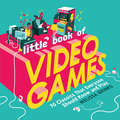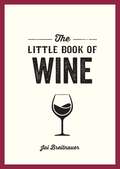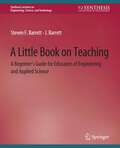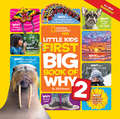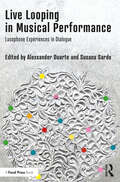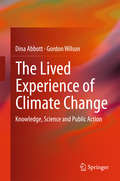- Table View
- List View
Lithography (Iste Ser.)
by Stefan LandisLithography is now a complex tool at the heart of a technological process for manufacturing micro and nanocomponents. A multidisciplinary technology, lithography continues to push the limits of optics, chemistry, mechanics, micro and nano-fluids, etc. This book deals with essential technologies and processes, primarily used in industrial manufacturing of microprocessors and other electronic components.
Lithography
by Stefan LandisLithography is now a complex tool at the heart of a technological process for manufacturing micro and nanocomponents. A multidisciplinary technology, lithography continues to push the limits of optics, chemistry, mechanics, micro and nano-fluids, etc. This book deals with essential technologies and processes, primarily used in industrial manufacturing of microprocessors and other electronic components.
Lithography for VLSI: VLSI Electronics Microstructure Science (ISSN #16)
by Norman G. Einspruch R. K. WattsVLSI Electronics Microstructure Science, Volume 16: Lithography for VLSI treats special topics from each branch of lithography, and also contains general discussion of some lithographic methods.This volume contains 8 chapters that discuss the various aspects of lithography. Chapters 1 and 2 are devoted to optical lithography. Chapter 3 covers electron lithography in general, and Chapter 4 discusses electron resist exposure modeling. Chapter 5 presents the fundamentals of ion-beam lithography. Mask/wafer alignment for x-ray proximity printing and for optical lithography is tackled in Chapter 6. Chapters 7 and 8 on metrology deal with the characterization of lithography by measurements of various types.Engineers, scientists, and technical managers in the semiconductor industry, and engineering and applied physics faculty and graduate students will find the text very useful.
A Little Book about BIG Chemistry: The Story of Man-Made Polymers (SpringerBriefs in Materials)
by Jim MassyThe brief explains in simple terms the essentials of polymer chemistry and how polymers came to be discovered by pioneers in this field. It relates the many uses of polymers, including those not widely recognised by the lay person. The chemistry of polymerisation and the influence of chemical structure and additives on properties are described. Ethical issues are considered, especially in the context of huge tonnages of plastics. Finally short paragraphs on more than 30 common polymers are listed chronologically with chemical structures, properties and applications. It will appeal to those with connections to or within the plastics, rubber and textile industries, science students, members of other science disciplines using polymers, as well as people just curious to know about everyday plastics.
The Little Book of Bees: A Pocket Guide to the Wonderful World of Bees
by Vicki VrintDiscover the fascinating story of these marvels of nature. Learn about their beehaviours, why they are under threat and how they are essential to our existence. From tips to help identify different species to bee habitats and folklore, this is the ideal companion for any bee lover looking to protect the future of our furry little friends.
Little Book of Tractors (Little Book Of Ser.)
by Ellie CharlestonThe Little Book of Tractors is full of black and white and colour photographs tracing the history of mechanised farming. The story of the tractor begins with the development of steam power and early stationery or portable engines. It then moves on to large cumbersome and expensive traction engines, the first farming machines with a driver and powered wheels. But it is the development f mass produced machines that enabled the tractor to be affordable for the masses - and with this came a transformation to the way farmers worked and a complete change to the way the countryside looked.
Little Book of Video Games: 70 Classics That Everyone Should Know and Play
by Melissa BrinksRevisit your favorites, find something new, or play your way through this light-hearted guide to the most celebrated and iconic arcade, console, and computer games from the 1950s to the 2000s.An accessible, informative look at the history and evolution some of the most popular and iconic video games from their early beginnings up to the 2000s. Author Melissa Brinks explores each influential game and its impact on they would have on the games that would follow, with brief, engaging profiles and surprising trivia that is perfect for fans of all levels.From the groundbreaking games of the 1950s to the genre-defining games of the 60s and 70s to the modern classics of the 1990s and early 2000s, The Little Book of Video Games includes games from a wide variety of genres and consoles including (but not limited to): Pong, Spacewar!, Adventure, Pac-Man, Rogue, Donkey Kong, Galaga, Dragon's Lair, Tetris, Super Mario Bros., The Oregon Trail, Castlevania, Legend of Zelda, Final Fantasy, Mega Man, SimCity, Mother, Mortal Kombat, Myst, Doom, Warcraft, Diablo, Tomb Raider, Pokémon, Tamagotchi, GoldenEye 007, Ultima Online, Metal Gear Solid, Dance Dance Revolution, Half-Life, Silent Hill, The Sims, and more.Now you can learn, share, and enjoy your favorite classic video games without having to press a power button!
The Little Book of Wine: A Pocket Guide to the Wonderful World of Wine Tasting, History, Culture, Trivia and More
by Jai BreitnauerWhether you're a qualified quaffer or an aspiring aficionado, raise a glass to the wonders of wine with this vintage blend of culture, history and trivia Pinot, Chardonnay, Merlot, Riesling... There are so many delicious varieties of wine to delight both the nose and palate - and no other beverage has ever created such excitement and emotion over its vast history. It's also a subject whose complexities can be baffling and mysterious to the uninitiated. Luckily, this small but full-bodied pocket guide is here to unveil all the secrets of this most marvellous drink. Packed with a wealth of information on the world of wine, this miscellany is the perfect gift for any wine fan, from the seasoned expert to the casual drinker. Whether you favour red or white, dry or sweet, sparkling or still, indulge your inner sommelier and celebrate the gift of the grape with The Little Book of Wine.
A Little Book on Teaching: A Beginner’s Guide for Educators of Engineering and Applied Science (Synthesis Lectures on Engineering)
by Steven BarrettIt is often a challenging and overwhelming transition to go from being a student to being a teacher. Many new faculty members of engineering and science have to make this dramatic transition in a very short time. In the same closing months of your Ph.D. program you are trying to complete your research, finish and defend your dissertation, find a job, move to a new location, and start a new job as a faculty member. If you are lucky, you've had the opportunity to serve as a teaching assistant and possibly have taught a university-level course. If you have served as a research assistant, your teaching opportunities may have been limited. Somehow, in this quick transition from student to teacher, one is supposed to become a good teacher and be ready for the first day of school. This book is intended as a basic primer on college-level teaching and learning for a new faculty member of engineering and applied science. New faculty members in other disciplines will find much of the information applicable to their area of expertise as well. First and foremost, this book is about learning and teaching. However, it also provides helpful information on related topics such as mentorship, student challenges, graduate students, tenure, and promotion and accreditation. This book is also intended as a reference for seasoned professionals. It is a good reference for those mentoring the next generation of college educators. Table of Contents: List of Figures / What makes a Great Teacher? / A little learning theory / Preparation for the first day of classes / Assessment / Beyond the first day
Little Kids First Big Book of Why 2 (First Big Book)
by National Geographic Kids Jill EsbaumFollowing up on the best-selling Little Kids First Big Book of Why, the next book in the hit Little Kids First Big Book series features even more of the endless "Why?" questions preschoolers love to ask!
A Little Less Arctic: Top Predators in the World's Largest Northern Inland Sea, Hudson Bay
by Steven H. Ferguson Lisa L. Loseto Mark L. MalloryIn Arctic Canada, Hudson Bay is a site of great exploration history, aboriginal culture, and a vast marine wilderness supporting large populations of marine mammals and birds. These include some of the most iconic Arctic animals like beluga, narwhal, bowhead whales, and polar bears. Due to the challenges of conducting field research in this region, some of the mysteries of where these animals move, and how they are able to survive in such seemingly inhospitable, ice-choked habitats are just now being unlocked. For example, are polar bears being replaced by killer whales? This new information could not be more salient, as the Hudson Bay Region is undergoing rapid environmental change due to global warming, as well as increased pressures from industrial development interests. A Little Less Arctic brings together some of the world’s leading Arctic scientists to present the current state of knowledge on the physical and biological characteristics of Hudson Bay.
Little Vast Rooms Of Undoing (PDF): Exploring Identity And Embodiment Through Public Toilet Spaces
by Dara BlumenthalPublic toilets are places where individual identity is put to the test through experiences of fear, anxiety, shame, and embarrassment, yet also places where we shore up, confirm, and check the status of our gendered identities. In these highly gendered and sex-segregated places, people of various and varied identities come together and separately conduct their `business' through socially contingent toileting habits and behaviors. Based on empirical research with men, women, gender non-conforming, and trans individuals who have a range of sexual identities, Little Vast Rooms of Undoing attempts to understand a nearly universal aspect of daily life in the contemporary West. Through a meditation on socially dictated practices and their associated emotions, it argues that experiences within public toilets expose the fissures of individual identity construction and understanding and opening the possibilities for a more relational and cohesive experience of the embodied self.
Liutex and Third Generation of Vortex Definition and Identification: An Invited Workshop from Chaos 2020
by Chaoqun Liu Yiqian WangThis book collects papers presented in the Invited Workshop, “Liutex and Third Generation of Vortex Definition and Identification for Turbulence,” from CHAOS2020, June 9-12, 2020, which was held online as a virtual conference. Liutex is a new physical quantity introduced by Prof. Chaoqun Liu of the University of Texas at Arlington. It is a vector and could give a unique and accurate mathematical definition for fluid rotation or vortex. The papers in this volume include some Liutex theories and many applications in hydrodynamics, aerodynamics and thermal dynamics including turbine machinery. As vortex exists everywhere in the universe, a mathematical definition of vortex or Liutex will play a critical role in scientific research. There is almost no place without vortex in fluid dynamics. As a projection, the Liutex theory will play an important role on the investigations of the vortex dynamics in hydrodynamics, aerodynamics, thermodynamics, oceanography, meteorology, metallurgy, civil engineering, astronomy, biology, etc. and to the researches of the generation, sustenance, modelling and controlling of turbulence.
Liutex and Third Generation of Vortex Identification: Workshop from Aerospace and Aeronautics World Forum 2021 (Springer Proceedings in Physics #288)
by Yiqian Wang Yisheng Gao Chaoqun LiuThis proceedings highlights the applications of the newly introduced physical quantity Liutex in hydrodynamics and aerodynamics. Liutex is used to represent the fascinating rotational motion of fluids, i.e., the vortex. Ubiquitously seen in nature and engineering applications, the definition of vortices has been elusive. The Liutex vector provides a unique and systematic description of vortices. The proceedings collects papers presented in the invited workshop "Liutex and Third Generation of Vortex Identification for Engineering Applications" from Aerospace and Aeronautics World Forum 2021. The papers in this book cover both the theoretical aspects of Liutex and many applications in hydrodynamics and aerodynamics. The proceedings is a good reference for researchers in fluid mechanics who are interested in learning about the wide scope of applications of Liutex and using it to develop a new understanding of their research subjects.
Live Audio: The Art of Mixing a Show
by Dave SwallowA practical hands on 'in the trenches' guide to mixing and live sound from an author who has a lot of experience in the field.
Live Audio: The Art of Mixing a Show
by Dave SwallowA practical hands on 'in the trenches' guide to mixing and live sound from an author who has a lot of experience in the field.
The Live Event Video Technician
by Tim KuschelThe Live Event Video Technician covers terms, format types, concepts, and technologies used in video production for corporate meetings, concerts, special events, and theatrical productions. The book begins by providing a history of the industry and an overview of important roles and functions therein. It then discusses various display technologies such as LED walls and video projection, as well as video systems for converting and switching of various types of sources. Presenting the cornerstone formats, connectors, and methodologies of visual technology, this book offers a strong foundation to help readers navigate this ever-changing field. Written in an accessible tone, the book clarifies jargon and is an overarching source of knowledge for the role of the video technician, for which there has previously been little formal training. The Live Event Video Technician provides a wealth of practical information for students of media and communications courses, readers with a novice or entry-level understanding of video and AV production, and anyone with an interest in working as technical personnel in live event production.
The Live Event Video Technician
by Tim KuschelThe Live Event Video Technician covers terms, format types, concepts, and technologies used in video production for corporate meetings, concerts, special events, and theatrical productions. The book begins by providing a history of the industry and an overview of important roles and functions therein. It then discusses various display technologies such as LED walls and video projection, as well as video systems for converting and switching of various types of sources. Presenting the cornerstone formats, connectors, and methodologies of visual technology, this book offers a strong foundation to help readers navigate this ever-changing field. Written in an accessible tone, the book clarifies jargon and is an overarching source of knowledge for the role of the video technician, for which there has previously been little formal training. The Live Event Video Technician provides a wealth of practical information for students of media and communications courses, readers with a novice or entry-level understanding of video and AV production, and anyone with an interest in working as technical personnel in live event production.
Live Feeds in Marine Aquaculture
by Lesley McEvoy Josianne StøttrupAs the expansion in world aquaculture continues at a very high rate, so does the need for information on feeding of cultivated fish and shellfish. In the larval and juvenile phases of many species, the use of manufactured feed is not possible. This important book covers in detail the biology and culture of the main live prey and microalgae used as feeds in the aquaculture of major commercial species including shrimps, sea bass, halibut, cod and bivalves. Contents include comprehensive details of the status of marine aquaculture in relation to live prey, and chapters covering the biology, production, harvesting, processing and nutritional value of microalgae and the main prey species: rotifers, Artemia and copepods. The editors have drawn together an impressive international team of contributors, providing a work that is set to become the standard reference and practical guide on the subject for many years to come. Live Feeds in Marine Aquaculture is an essential purchase for anyone involved in marine aquaculture, including fish farmers, researchers, and personnel in feed and equipment companies supplying the aquaculture trade. An extremely valuable tool as a reference and practical manual for students and professionals alike; libraries in all universities and research establishments where biological and aquatic sciences and aquaculture are studied and taught, should have copies available on their shelves.
Live Food in Aquaculture: Proceedings of the Live Food and Marine Larviculture Symposium held in Nagasaki, Japan, September 1–4, 1996 (Developments in Hydrobiology #124)
by A. Hagiwara T. W. Snell E. Lubzens C. S. TamaruThis proceedings volume includes selected papers presented at the international symposium `Live Food Organisms in Marine Larviculture' held in Nagasaki, Japan, September 1-4 1996. This international symposium focused on live food organisms for the larval rearing of marine animals. Recent achievements in the fundamental biology (such as physiology, ecology, taxonomy, life cycle and nutrition) of live planktonic animals used as feed in aquaculture were combined with recent technological advances on larval rearing methods. This volume also provides future directions for the application of basic science to the rearing of aquatic animals.
Live Looping in Musical Performance: Lusophone Experiences in Dialogue
by Alexsander Duarte Susana SardoLive Looping in Musical Performance offers a diverse range of interdisciplinary perspectives on the application of live looping technology by lusophone performers and composers. This book explores various aspects, including the aesthetic component, instrumentation, and setup, highlighting the versatility of this technology in music-making. Written by musicians and researchers from Portuguese-speaking countries, this book comprises eleven chapters that delve into various musical contexts, genres, and practices. The novelty of including collaborative texts written alongside non-professional researchers offers the possibility of drawing from real experience to consider how live looping has been changing and "cyborguising" the concept of music, the ritual of the performance, the identity of the musicians, and the public's expectations. Live Looping in Musical Performance provides cutting-edge reading for composers and performers, as well as ethnomusicologists, students, and researchers working in the areas of music production, technology, and performance. This book addresses a broader audience, both academic and non-academic, who are interested in new processes of musical creativity in a post-human world.
Live Looping in Musical Performance: Lusophone Experiences in Dialogue
Live Looping in Musical Performance offers a diverse range of interdisciplinary perspectives on the application of live looping technology by lusophone performers and composers. This book explores various aspects, including the aesthetic component, instrumentation, and setup, highlighting the versatility of this technology in music-making. Written by musicians and researchers from Portuguese-speaking countries, this book comprises eleven chapters that delve into various musical contexts, genres, and practices. The novelty of including collaborative texts written alongside non-professional researchers offers the possibility of drawing from real experience to consider how live looping has been changing and "cyborguising" the concept of music, the ritual of the performance, the identity of the musicians, and the public's expectations. Live Looping in Musical Performance provides cutting-edge reading for composers and performers, as well as ethnomusicologists, students, and researchers working in the areas of music production, technology, and performance. This book addresses a broader audience, both academic and non-academic, who are interested in new processes of musical creativity in a post-human world.
Live Music Production: Interviews with UK Pioneers
by Richard AmesThis book presents the days of live music production in the UK spanning the late '60s to the mid-'80s, when rock music was enjoying a meteoric rise in popularity. The author, Richard Ames, will take you on a true behind-the-scenes journey of discovery. You’ll learn who the people were, where they came from and how they went on to pioneer the first companies that would become the lifeblood of a unique industry. The interviews contained in this book record and present the raw stories of a few of the original innovators who set the stage for their performers but also for the hundreds of technicians who would tour the world following in their footsteps. The pioneers presented in these interviews share with the reader countless candid anecdotes that convey how their curious enthusiasm, energy, dedication, and general can-do attitude was the driving force behind the creation of the many companies we know of as common place today. The book presents interviews that span varied aspects of live music production including lighting, sound, rigging, staging, trucking, bussing and catering. Live Music Production captures a piece of social history that promises to inform, entertain and delight.
Live Music Production: Interviews with UK Pioneers
by Richard AmesThis book presents the days of live music production in the UK spanning the late '60s to the mid-'80s, when rock music was enjoying a meteoric rise in popularity. The author, Richard Ames, will take you on a true behind-the-scenes journey of discovery. You’ll learn who the people were, where they came from and how they went on to pioneer the first companies that would become the lifeblood of a unique industry. The interviews contained in this book record and present the raw stories of a few of the original innovators who set the stage for their performers but also for the hundreds of technicians who would tour the world following in their footsteps. The pioneers presented in these interviews share with the reader countless candid anecdotes that convey how their curious enthusiasm, energy, dedication, and general can-do attitude was the driving force behind the creation of the many companies we know of as common place today. The book presents interviews that span varied aspects of live music production including lighting, sound, rigging, staging, trucking, bussing and catering. Live Music Production captures a piece of social history that promises to inform, entertain and delight.
The Lived Experience of Climate Change: Knowledge, Science and Public Action
by Dina Abbott Gordon WilsonThis book explores the idea that daily lived experiences of climate change are a crucial missing link in our knowledge that contrasts with scientific understandings of this global problem. It argues that both kinds of knowledge are limiting: the sciences by their disciplines and lived experiences by the boundaries of everyday lives. Therefore each group needs to engage the other in order to enrich and expand understanding of climate change and what to do about it.Complemented by a rich collection of examples and case studies, this book proposes a novel way of generating and analysing knowledge about climate change and how it may be used. The reader is introduced to new insights where the book:• Provides a framework that explains the variety of simultaneous, co-existing and often contradictory perspectives on climate change.• Reclaims everyday experiential knowledge as crucial for meeting global challenges such as climate change.• Overcomes the science-citizen dichotomy and leads to new ways of examining public engagement with science. Scientists are also human beings with lived experiences that filter their scientific findings into knowledge and actions.• Develops a ‘public action theory of knowledge’ as a tool for exploring how decisions on climate policy and intervention are reached and enacted.While scientists (physical and social) seek to explain climate change and its impacts, millions of people throughout the world experience it personally in their daily lives. The experience might be bad, as during extreme weather, engender hostility when governments attempt mitigation, and sometimes it is benign. This book seeks to understand the complex, often contradictory knowledge dynamics that inform the climate change debate, and is written clearly for a broad audience including lecturers, students, practitioners and activists, indeed anyone who wishes to gain further insight into this far-reaching issue.






